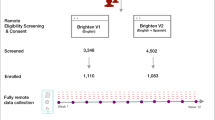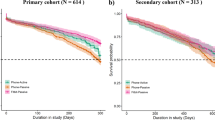Abstract
Digital footprints, the automatically accumulated by-products of our technology-saturated lives, offer an exciting opportunity for psychiatric research. The commercial sector has already embraced the electronic trails of customers as an enabling tool for guiding consumer behaviour, and analogous efforts are ongoing to monitor and improve the mental health of psychiatric patients. The untargeted collection of digital footprints that may or may not be health orientated comprises a large untapped information resource for epidemiological scale research into psychiatric disorders. Real-time monitoring of mood, sleep and physical and social activity in a substantial portion of the affected population in a naturalistic setting is unprecedented in psychiatry. We propose that digital footprints can provide these measurements from real world setting unobtrusively and in a longitudinal fashion. In this perspective article, we outline the concept of digital footprints and the services and devices that create them, and present examples where digital footprints have been successfully used in research. We then critically discuss the opportunities and fundamental challenges associated digital footprints in psychiatric research, such as collecting data from different sources, analysis, ethical and research design challenges.
This is a preview of subscription content, access via your institution
Access options
Subscribe to this journal
Receive 12 print issues and online access
$259.00 per year
only $21.58 per issue
Buy this article
- Purchase on Springer Link
- Instant access to full article PDF
Prices may be subject to local taxes which are calculated during checkout


Similar content being viewed by others
References
Bellack AS, Hersen M. Handbook of Behavior Therapy in the Psychiatric Setting [Internet]. Springer US: Boston, MA, 1993. Available at: http://link.springer.com/10.1007/978-1-4899-2430-8.
Markowetz A, Błaszkiewicz K, Montag C, Switala C, Schlaepfer TE . Psycho-Informatics: big data shaping modern psychometrics. Med Hypotheses 2014; 82: 405–411.
Phillips J, Frances A, Cerullo MA, Chardavoyne J, Decker HS, First MB et al. The six most essential questions in psychiatric diagnosis: a pluralogue part 1: conceptual and definitional issues in psychiatric diagnosis. Philos Ethics Humanit Med 2012; 7: 3.
Cuthbert BN . The RDoC framework: facilitating transition from ICD/DSM to dimensional approaches that integrate neuroscience and psychopathology. World Psychiatry 2014; 13: 28–35.
Nisbett RE, Wilson TD. Telling more than we can know: verbal reports on mental processes. 1977 [cited 8 February 2016]; Available from http://deepblue.lib.umich.edu/handle/2027.42/92167.
Ben-Zeev D, Scherer EA, Wang R, Xie H, Campbell AT . Next-generation psychiatric assessment: Using smartphone sensors to monitor behavior and mental health. Psychiatr Rehabil J. 2015; 38: 218–226.
McInnis MG, Greden JF. Longitudinal studies: an essential component for complex psychiatric disorders. Neurosci Res [Internet]. [cited 18 January 2016]; Available from http://www.sciencedirect.com/science/article/pii/S0168010215001522.
Digital Footprints - An Internet Society Reference Framework [Internet]. [cited 4 February 2016]. Available from http://www.internetsociety.org/sites/default/files/Digital%20Footprints%20-%20An%20Internet%20Society%20Reference%20Framework.pdf.
World Internet Users Statistics and 2015 World Population Stats [Internet]. [cited 18 April 2016]. Available from http://www.internetworldstats.com/stats.htm.
Kosinski M, Stillwell D, Graepel T . Private traits and attributes are predictable from digital records of human behavior. Proc Natl Acad Sci 2013; 110: 5802–5805.
Youyou W, Kosinski M, Stillwell D . Computer-based personality judgments are more accurate than those made by humans. Proc Natl Acad Sci 2015; 112: 1036–1040.
Gittelman S, Lange V, Gotway Crawford CA, Okoro CA, Lieb E, Dhingra SS et alA New Source of Data for Public Health Surveillance: Facebook Likes. J Med Internet Res [Internet]. [cited 11 january 2016];17(4), 2015. Available at: http://www.ncbi.nlm.nih.gov/pmc/articles/PMC4419195/.
GSMA. The Mobile Economy 2015 [Internet]. [cited 27 April 2016]. Available from http://www.gsmamobileeconomy.com/GSMA_Global_Mobile_Economy_Report_2015.pdf.
Reibstein DJ . What attracts customers to online stores, and what keeps them coming back? J Acad Mark Sci 2002; 30: 465–473.
Hui SK, Inman JJ, Huang Y, Suher J . The effect of in-store travel distance on unplanned spending: applications to mobile promotion strategies. J Mark 2013; 77: 1–16.
Glueck J. McDonald’s vs Taco Bell: Who’s winning the breakfast wars? – Foursquare Direct [Internet]. Medium. 2015 [cited 3 September 2016]. Available at: https://medium.com/foursquare-direct/mcdonald-s-vs-taco-bell-who-s-winning-the-breakfast-wars-a27f11e58483#.7twa5zopc.
Salonen V, Karjaluoto H . Web personalization: the state of the art and future avenues for research and practice. Telemat Inform 2016; 33: 1088–1104.
Phan TQ, Airoldi EM . A natural experiment of social network formation and dynamics. Proc Natl Acad Sci 2015; 112: 6595–6600.
Godoy-Lorite A, Guimerà R, Sales-Pardo M . Long-term evolution of email networks: statistical regularities, predictability and stability of social behaviors. PLoS ONE 2016; 11: e0146113.
Pechey R, Monsivais P . Supermarket Choice, Shopping Behavior, Socioeconomic Status, and Food Purchases. Am J Prev Med. 2015; 49: 868–877.
The Jawbone Blog - [Internet]. The Jawbone Blog. [cited 5 May 2016]. Available from https://jawbone.com/blog.
Bryson A, MacKerron G . Are you happy while you work? Econ J 2016; doi:10.1111/ecoj.12269.
Pappalardo L, Simini F, Rinzivillo S, Pedreschi D, Giannotti F, Barabási A-L . Returners and explorers dichotomy in human mobility. Nat Commun 2015; 6: 8166.
Blumenstock J, Cadamuro G, On R . Predicting poverty and wealth from mobile phone metadata. Science 2015; 350: 1073–1076.
Nathan D, Shukla L, Kandasamy A, Benegal V . Facebook role play addiction – a comorbidity with multiple compulsive–impulsive spectrum disorders. J Behav Addict 2016; 5: 373–377.
Carli V, Durkee T, Wasserman D, Hadlaczky G, Despalins R, Kramarz E et al. The association between pathological internet use and comorbid psychopathology: a systematic review. Psychopathology 2013; 46: 1–13.
Beiwinkel T, Kindermann S, Maier A, Kerl C, Moock J, Barbian G et al. Using smartphones to monitor bipolar disorder symptoms: a pilot study. JMIR Ment Health 2016; 3: e2.
Glenn T, Monteith S. New measures of mental state and behavior based on data collected from sensors, smartphones, and the internet. Current Psychiatry Reports [Internet]. cited Oct 29 2015;16(12), 2014. Available at: http://link.springer.com/10.1007/s11920-014-0523-3.
Wenzel M, Kubiak T, Ebner-Priemer UW. Ambulatory assessment as a means oflongitudinal phenotypes characterization in psychiatric disorders. Neuroscience Research[Internet]. [cited 15 january 2016]; Available at: http://www.sciencedirect.com/science/article/pii/S0168010214002417.
Saeb S, Zhang M, Karr CJ, Schueller SM, Corden ME, Kording KP et al. Mobile phone sensor correlates of depressive symptom severity in daily-life behavior: an exploratory study. J Med Internet Res 2015; 17: e175.
Schwartz S, Schultz S, Reider A, Saunders EFH . Daily mood monitoring of symptoms using smartphones in bipolar disorder: a pilot study assessing the feasibility of ecological momentary assessment. J Affect Disord 2016; 191: 88–93.
Trust W. Digital Phenotypes – Health research in the digital age [Internet]. Wellcome Trust Blog. 2016 [cited 5 August 2016]. Available at: https://blog.wellcome.ac.uk/2016/03/08/digital-phenotypes-health-research-inthe-digital-age/.
Midata for personal current accounts [Internet]. [cited 14 January 2016]. Available from https://www.pcamidata.co.uk/.
Hafen E, Kossmann D, Brand A . Health data cooperatives - citizen empowerment. Methods Inf Med. 2014; 53: 82–86.
Shabo A . It’s time for health record banking!. Methods Inf Med 2014; 53: 63–65.
Case MA, Burwick HA, Volpp KG, Patel MS . Accuracy of smartphone applications and wearable devices for tracking physical activity data. J Am Med Assoc 2015; 313: 625–626.
Eagle N, (Sandy) Pentland A . Reality mining: sensing complex social systems. Pers Ubiquitous Comput. 2006; 10: 255–268.
Crayen C, Eid M, Lischetzke T, Courvoisier DS, Vermunt JK . Exploring dynamics in mood regulation–mixture latent Markov modeling of ambulatory assessment data. Psychosom Med 2012; 74: 366–376.
Passos IC, Mwangi B, Kapczinski F . Big data analytics and machine learning: 2015 and beyond. Lancet Psychiatry 2016; 3: 13–15.
Lipinski D, Nelson R . Problems in the use of naturalistic observation as a means of behavioral assessment. Behav Ther 1974; 5: 341–351.
Dawkins R. The extended phenotype: the long reach of the gene [Internet]. Oxford Paperbacks; 1999 [cited 27 April 2016]. Available from https://books.google.com/books?hl=en&lr=&id=vsIZAgAAQBAJ&oi=fnd&pg=PP2&dq=%22said+to+act.+I+happen+to+be+an+ethologist,+but+I+hope+preoccupations%22+%22to+enjoy+a+professional+book+as+a+spectator,+even+if+not+a%22+&ots=IztxVTABDn&sig=9YAyUoNInrRz6dmdL8SZdcsEvuo.
Zickuhr K, Madden M. Older adults and internet use [Internet]. Pew Research Center: Internet, Science & Tech. 2012 [cited 3 September 2016]. Available from http://www.pewinternet.org/2012/06/06/older-adults-and-internet-use/.
Ennis L, Rose D, Denis M, Pandit N, Wykes T . Can’t surf, won’t surf: the digital divide in mental health. J Ment Health Abingdon Engl 2012; 21: 395–403.
Jackson SL, Mejilla R, Darer JD, Oster NV, Ralston JD, Leveille SG et al. Patients who share transparent visit notes with others: characteristics, risks, and benefits. J Med Internet Res 2014; 16: e247.
U.S. Customer Loyalty Program Memberships Top 3 Billion For First Time, 2015 COLLOQUY Census Shows [Internet]. COLLOQUY. [cited 8 May 2016]. Available from: /latest-news//.
Monica Anderson. Technology Device Ownership: 2015 [Internet]. Pew Research Center: Internet, Science & Tech. 2015 [cited 8 May 2016]. Available from http://www.pewinternet.org/2015/10/29/technology-device-ownership-2015/.
Rainie L comments DC. Census: Computer ownership, internet connection varies widely across U.S. [Internet]. Pew Research Center. 2014 [cited 8 May 2016]. Available at http://www.pewresearch.org/fact-tank/2014/09/19/census-computer-ownership-internet-connection-varies-widely-across-u-s/.
Andrew Perrin. Social Media Usage: 2005–2015 [Internet]. Pew Research Center: Internet, Science & Tech. 2015 [cited 8 May 2016]. Available at: http://www.pewinternet.org/2015/10/08/social-networking-usage-2005-2015/.
Internet Users by Country (2016) - Internet Live Stats [Internet]. [cited 8 May 2016]. Available at http://www.internetlivestats.com/internet-users-by-country/.
Smart Home Ecosystem: IoT and Consumers [Internet]. [cited 8 May 2016]. Available at: http://www.parksassociates.com/whitepapers/iot-smart-devices.
Author information
Authors and Affiliations
Corresponding author
Ethics declarations
Competing interests
The authors declare no conflict of interest.
PowerPoint slides
Rights and permissions
About this article
Cite this article
Bidargaddi, N., Musiat, P., Makinen, VP. et al. Digital footprints: facilitating large-scale environmental psychiatric research in naturalistic settings through data from everyday technologies. Mol Psychiatry 22, 164–169 (2017). https://doi.org/10.1038/mp.2016.224
Received:
Revised:
Accepted:
Published:
Issue Date:
DOI: https://doi.org/10.1038/mp.2016.224
This article is cited by
-
Using New Technologies and Wearables for Characterizing Sleep in Population-based Studies
Current Sleep Medicine Reports (2024)
-
Digital footprints as a new translational approach for mental health care: a commentary
Discover Mental Health (2023)
-
Exploring the digital footprint of depression: a PRISMA systematic literature review of the empirical evidence
BMC Psychiatry (2022)
-
Social Media and Mental Health: Benefits, Risks, and Opportunities for Research and Practice
Journal of Technology in Behavioral Science (2020)
-
Combining mobile-health (mHealth) and artificial intelligence (AI) methods to avoid suicide attempts: the Smartcrises study protocol
BMC Psychiatry (2019)



